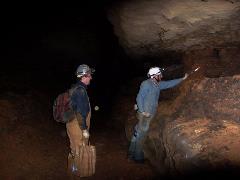Karst Groundwater Contaminants in Western Illinois: Comparison of Current Conditions with Historical Data
Principal Investigator: Walt Kelly
Sponsors: National Great Rivers Research and Education Center (NGRREC)
Project Period: 2013–2014
Previous studies of groundwater quality in the karst aquifers of the Sinkhole Plain of southwestern Illinois (Monroe and St. Clair Counties) showed high levels of contamination with fecal coliform bacteria and agricultural chemicals (Taylor et al., 2000). In this study, karst groundwater quality in the area was reassessed to determine whether improved land-use practices are now reflected in water quality improvements.
Findings to Date
Water chemistry data collected from springs and cave streams during this study were roughly comparable to samples collected 15 years earlier (Taylor et al., 2000). The water quality data indicated a karst system widely but moderately contaminated by land use activities. Almost all of the samples had elevated levels of nitrate, chloride, fecal bacteria, and pharmaceuticals and personal care products (PPCPs). A plot of chloride vs. nitrate indicates that most of the samples represented mixed sources of contamination, which is common for springs (Figure 1). Previous studies have suggested that synthetic fertilizer, septic effluent, and livestock are the primary sources of contamination in the region. There is a positive correlation between chloride and nitrate concentrations, suggesting these two contaminants are coming from the same sources (e.g., private septic systems and animal waste/manure as fertilizer). The PPCPs analyzed were all from human sources. The number of detections and combined concentration are positively correlated with chloride, suggesting septic discharge as the source of both. The prevalence of human bacteria also suggested septic system contamination. During the project, we partnered with Clifftop NFP [http://www.clifftopalliance.org/], a non-profit conservation and land-trust organization within the study area comprised of local stakeholders, including farmers, community leaders, and educators. Clifftop assisted in fieldwork, conveyed findings to the local community, and leveraged their volunteer time.
Project Publications
Final Report: Taylor, S. J., W. R. Kelly, S. V. Panno, R. Weck, W. Zheng, Y. Zhang, and W.-T. Liu. 2014. Karst groundwater contaminants in western Illinois: comparison of current conditions with historical data. Illinois Natural History Survey, Technical Report 2014(22):1-53.
https://www.ideals.illinois.edu/handle/2142/50295
Selected Related Publications
Taylor, S. J., D. W. Webb and S. V. Panno. 2000. Spatial and temporal analyses of the bacterial fauna and water, sediment, and amphipod tissue chemistry within the range of Gammarus acherondytes. Illinois Natural History Survey, Center for Biodiversity, Technical Report 2000(18):1-115.
http://wwn.inhs.illinois.edu/~sjtaylor/pdf/TaylorWebbPanno2000.pdf
Presentations
Taylor, S. J., W. R. Kelly, S. V. Panno, R. Weck, W. Zheng, Y. Zhang, and W.-T. Liu. Karst groundwater contaminants in western Illinois: comparison of current conditions with historical data. National Great Rivers Research and Education Center (NGRREC) Conference, Alton, IL. June 11, 2014.
